
The
wrong place at the wrong time
Background
By March 1942 the Japanese military domination of
South East Asia by its land, sea and air forces, had
reached the Dutch East Indies (Now Indonesia).
With the invasion of Java only a matter of days
away, the allied command decided that the only
remaining option for the Dutch nationals to escape
from Java was an evacuation by air.
The logical and realistic safe haven at this stage was
Broome, a sleepy pearl fishing town near the top of
Western Australia, a distance of 900 kilometres (9
hours) by air from Java.
Unfortunately events transpired that turned this idyllic
location into a tragic nightmare. On the morning of
March 3rd 1942, Broome was packed with allied
aircraft. Flying boats were moored overnight in
Roebuck Bay, whilst bombers and transports were
arriving and departing from the town airstrip.
At
9.30 nine Japanese Zero A6M fighters
peeled off to the attack. Some thought they were
aircraft of the Australian Air Force doing a flyby.
They made 3 to 4 strafing attacks with very
accurate canon and machine gun fire. In no
time the fuel laden flying boats were exploding
in fireballs and sinking. The people inside the
aircraft fortunate enough to escape the hail of
gunfire, died in the burning waters as the leaking
fuel and oil caught fire.

Above: Unique aerial photo of Roebuck Bay taken
by a Japanese 'Babs' observation aircraft
during the attack
Those unfortunate enough to survive the burning
fuel, were only to be taken by Sharks. The remaining
handful of survivors were picked up in small boats
after being carried out to sea by the strong tide.
The survivors told of the horrific sights they had
seen, and the ghastly injuries people had suffered.
The Japanese attack on Broome took Australia
and the world unawares. Nobody thought that
an air attack would be mounted on the Australian
mainland, or that it could be so fast and so
devastating.
In just 20 minutes 23 allied transports, bombers
and
flying boats were either burning furiously on the airstrip,
or sinking in Roebuck Bay. The awful irony of this tragic
attack is the fact that the Japanese Commander
Shibata had no idea who, or what was in the aircraft.
All he knew was that here was a large concentration
of allied aircraft in an area with no defenses, and
therefore legitimate military targets.

Above: Present day aerial shot, taken from
the end of the airfield, looking towards
Roebuck Bay. Photo Jon Davison
Although the town of Broome was straffed during
the attack, it was not the prime target. In a letter
to Merv Prime (author of 'Broome's
one day war')
in the late 1970's, Shibata, the Japanese Commander
apologised by saying "..Please accept my apologies
if some stray bullets fell into the town".
The Japanese pilots concentrated their fire on the
moored flying boats and the aircraft on the town
airstrip, the Imperial Japanese Navy killed scores
if not hundreds of innocent civilians who's only
crime was simply to be caught in the wrong place
at the wrong time.
Over the course of the previous two weeks 8,000
Dutch and other Allied civilians were airlifted out
of Java to escape the Japanese invasion. They
were transported by a collection of aircraft from
different nations, RAAF, USN, RAF, KLM, USAAF.
and the MLD using Catalina, Dornier and
'C'
Class Empire flying boats,
plus B17, B24, DC3
bombers and transports.

Burnt
out bomber on the Broome airstrip.
Photo Via J.D. Rorrison
The
flights took about 9 hours to reach the
‘safe haven’ of Western Australia. On any one
day, up to 57 aircraft were arriving and leaving
Broome. On the morning of the 3rd March, 15
flying boats crammed with civilians were moored
in Roebuck Bay, an assortment of transports
and bombers were also on the town airstrip.
All the passengers stayed on the flying boats
overnight due to the lack of accommodation in
Broome, plus the infamous 8 metre tides
hampered ship-to-shore ferrying. Most aircraft
were being refueled for the journey to Perth
and other mainland destinations, whilst others
were arriving after the long flight from Java.
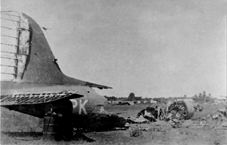
Burnt out Dutch
DC3 on the Broome air strip.
The Zeros took the town by complete surprise,
nobody was prepared for such an event.
There was no fighter defence, no antiaircraft
weapons. Such was the surprise that not
one aircraft escaped the destruction.
Photo: Les Menhennet

Commander Takeo Shibata,
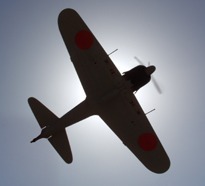
Mitsubishi A6M2
Zero. One Zero was
destroyed over Broome, another crashed
south of Roti Island,
Timor,
on the
return journey due to fuel loss and
battle damage.
Photo
by Jon Davison

Consolidated
PBY Catalina flying boat.
Eight similar to this were destroyed at
Broome.
Photo Jon Davison

Dornier Do24 flying boat. Five of these
were destroyed at Broome.
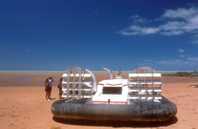
Hovercraft
on the mudflats of Roebuck Bay.
Photo Jon Davison
AIRCRAFT
DESTROYED.
- Top
As a direct result of the attack
5 x Dornier Do24
(Marine Luchtvaardienst) flying boats
2 x Consolidated LB30 Liberator
(USAAF) bomb/transport
2 x Boeing B17 'Flying Fortresses'
(USAAF) bomber
1 x Lockheed Lodestar
(NEI) (bomber/transport
2 x Douglas DC-3 Dakotas
(NEI) transport
2 x Mitsubishi A6M Zeros
(Imperial Japanese Navy) fighter
8 x Consolidated PBY Catalinas
(USN/MLD/RAF) flying boat
2 x Short S.23 'C' Class Empire'
(BOAC/QEA/RAAF) flying boats
1 x Lockheed Hudson
(NEI) bomber/transport
25 aircraft in total
The
Carnot Bay Episode
Following the attack the Zero's headed
up the coast en-route to their base on
Timor. They were not expecting any more
action and were therefore surprised to
intercept a Dutch DC-3 airliner
approaching the WA coastline near
Carnot Bay. Click
for more on this story..
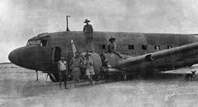
Exposed
wreckage of a flying boat
in Roebuck Bay. The massive
spring tides in Broome expose these
hulks every year. The deep water
wrecksare the subject of the Zero Hour
documentary.
found. Photo courtesy Merv Prime

Army personnel sitting
on a Japanese
'drop-tank' from one of the attacking
Zero
fighters. These fuel tanks gave
rise to the mistaken belief that Broome
was bombed.
Photo courtesy Merv Prime

One aircraft, a B24/LB30
Liberator,
managed to take off just as the Zero's
began their attack. As it was turning
south to Perth, it was shot down into
the sea. Only one man escaped
out of 20 - 30 servicemen on board.
After 24 hours at sea he made it to
shore, More..
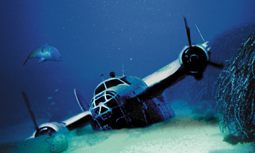
Digital
B24 Illustration by Jon Davison
The Film Story - Top
Western Australian based film company
Prospero Films ('Dive School' &
'Paying for the Piper') are currently
producing a series of three films
'The Shipwreck Detectives' dealing with
underwater wreck sites in WA waters.
Zero Hour is one of these stories.
Prospero Films organised for the
handful of surviving aircrew to be in
Broome during the filming. Their
interviews form the background of
the story. Go to the Survivors page.
The WA Maritime Museum
were tasked
with the finding of the wrecks, excavating
the artefacts and conserving the site
for future generations.
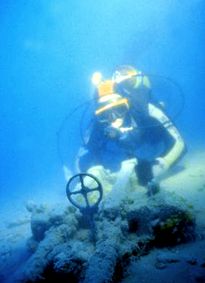
Recent photograph of an aircraft
machine gun (twin), complete with ring
sight, on the seabed at Roebuck Bay.
Photo by Eve Boogaard

Recent photo of Cable Beach.
Photo Jon Davison

Dornier Do-24
(X23) exposed at low tide in
Roebuck Bay
Photo
Stan Gadja